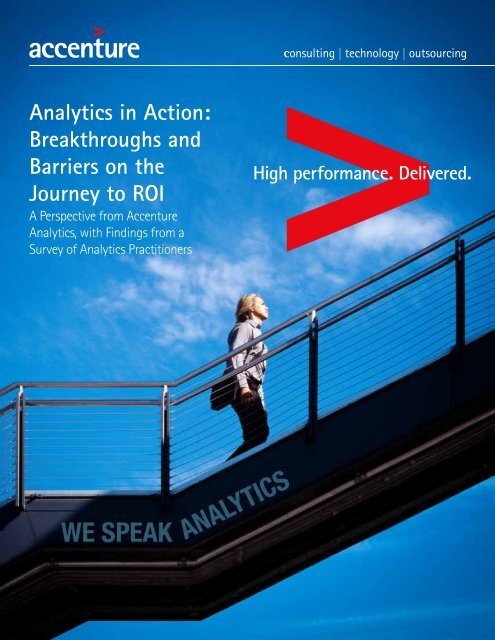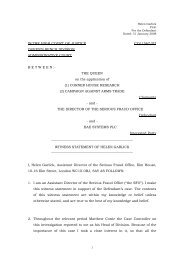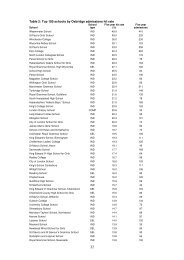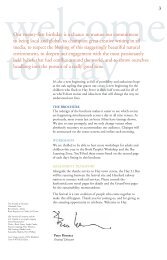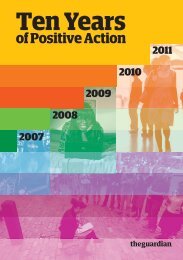Accenture Analytics in Action: Breakthroughs and ... - Guardian
Accenture Analytics in Action: Breakthroughs and ... - Guardian
Accenture Analytics in Action: Breakthroughs and ... - Guardian
Create successful ePaper yourself
Turn your PDF publications into a flip-book with our unique Google optimized e-Paper software.
<strong>Analytics</strong> <strong>in</strong> <strong>Action</strong>:<br />
<strong>Breakthroughs</strong> <strong>and</strong><br />
Barriers on the<br />
Journey to ROI<br />
A Perspective from <strong>Accenture</strong><br />
<strong>Analytics</strong>, with F<strong>in</strong>d<strong>in</strong>gs from a<br />
Survey of <strong>Analytics</strong> Practitioners
The adoption of analytics by<br />
bus<strong>in</strong>esses <strong>and</strong> organizations<br />
has been surg<strong>in</strong>g <strong>in</strong> recent years,<br />
particularly s<strong>in</strong>ce the appearance<br />
of Compet<strong>in</strong>g on <strong>Analytics</strong>: the<br />
New Science of W<strong>in</strong>n<strong>in</strong>g by<br />
Thomas H. Davenport <strong>and</strong> Jeanne<br />
G. Harris <strong>in</strong> 2007. 1 Where does<br />
the practice of analytics st<strong>and</strong><br />
today, <strong>and</strong> how are companies<br />
implement<strong>in</strong>g this potent new<br />
approach to decision-mak<strong>in</strong>g?<br />
Most importantly, is the practice<br />
deliver<strong>in</strong>g on the promise?<br />
1. Davenport, Thomas H. <strong>and</strong> Jeanne G. Harris.<br />
Compet<strong>in</strong>g on <strong>Analytics</strong>: the New Science of W<strong>in</strong>n<strong>in</strong>g.<br />
Harvard Bus<strong>in</strong>ess School Publish<strong>in</strong>g Corporation, 2007.<br />
Copyright © 2013 <strong>Accenture</strong>. All rights reserved.<br />
2
<strong>Analytics</strong> Aris<strong>in</strong>g<br />
Adoption is Up, <strong>and</strong> Leadership is On Board<br />
Even before many enterprises achieve<br />
measurable Return on Investment (ROI)<br />
from their current analytics capabilities,<br />
disruptive new forces <strong>and</strong> pressures are<br />
turn<strong>in</strong>g the journey to ROI <strong>in</strong>to a thrills<strong>and</strong>-spills<br />
obstacle course. Every analytics<br />
practitioner must contend with the advent<br />
of Big Data, not to mention accelerat<strong>in</strong>g<br />
technological <strong>in</strong>novation, ris<strong>in</strong>g dem<strong>and</strong>s for<br />
more sophisticated predictive applications,<br />
<strong>and</strong> the tricky task of embedd<strong>in</strong>g analytics<br />
across functional doma<strong>in</strong>s <strong>and</strong> enterprisewide<br />
processes.<br />
Gett<strong>in</strong>g analytics right requires clear vision,<br />
a steady h<strong>and</strong>, precision eng<strong>in</strong>eer<strong>in</strong>g <strong>and</strong> a<br />
read<strong>in</strong>ess to make course corrections while <strong>in</strong><br />
motion. Are today’s users of analytics up to<br />
the challenge?<br />
To answer these questions, <strong>Accenture</strong><br />
<strong>Analytics</strong> set out to survey current analytics<br />
practitioners. Six hundred telephone<br />
<strong>in</strong>terviews were conducted <strong>in</strong> August-<br />
September 2012 among Director-level<br />
executives <strong>and</strong> equivalent managers<br />
with<strong>in</strong> enterprise-level companies (1,000+<br />
employees) based <strong>in</strong> the US <strong>and</strong> UK who<br />
have knowledge of <strong>and</strong>/or responsibility<br />
for analytics with<strong>in</strong> their organization. This<br />
research, follow<strong>in</strong>g on our 2009 survey that<br />
provided a prelim<strong>in</strong>ary profile of the bus<strong>in</strong>ess<br />
analytics user, gives a current <strong>and</strong> exp<strong>and</strong>ed<br />
perspective on the breakthroughs <strong>and</strong><br />
barriers encountered by enterprises as they<br />
put analytics to work today.<br />
Copyright © 2013 <strong>Accenture</strong>. All rights reserved.<br />
<strong>Analytics</strong> is on the Rise <strong>and</strong> on<br />
the Agenda<br />
<strong>Analytics</strong> users tell us that analytics has<br />
arrived, is <strong>in</strong> wide use <strong>and</strong> is securely on<br />
the C-suite agenda. The use of analytics to<br />
aid decisions has <strong>in</strong>creased s<strong>in</strong>ce 2009, <strong>and</strong><br />
there has also been a def<strong>in</strong>itive <strong>in</strong>crease<br />
over the same period <strong>in</strong> the <strong>in</strong>tegration of<br />
analytics across the enterprise. One-third<br />
of companies surveyed report that they<br />
are aggressively us<strong>in</strong>g analytics across the<br />
entire enterprise. Fewer than 10 percent of<br />
respondents report that their companies are<br />
not mak<strong>in</strong>g any use of analytics, <strong>and</strong> fewer<br />
participants than <strong>in</strong> 2009 state that their<br />
use of analytics is h<strong>in</strong>dered by lack of data,<br />
technology, analytical skills <strong>and</strong>/or senior<br />
management support.<br />
Two-thirds of firms report hav<strong>in</strong>g appo<strong>in</strong>ted<br />
a senior figure such as a "chief data officer"<br />
to lead data management <strong>and</strong> analytics <strong>in</strong><br />
the last 18 months. Even among companies<br />
that did not make such an executive<br />
appo<strong>in</strong>tment, a large majority (71 percent)<br />
expect to do so <strong>in</strong> the near future.<br />
Strik<strong>in</strong>gly, 68 percent of survey respondents<br />
rated their senior management team as a<br />
whole to be highly or totally committed<br />
to analytics <strong>and</strong> fact-based decisionmak<strong>in</strong>g.<br />
Signals of commitment range<br />
from lead<strong>in</strong>g by example <strong>in</strong> dem<strong>and</strong><strong>in</strong>g<br />
fact-based decision-mak<strong>in</strong>g, <strong>and</strong> <strong>in</strong> specific<br />
actions such as hir<strong>in</strong>g analytical talent,<br />
mak<strong>in</strong>g <strong>in</strong>vestments <strong>in</strong> tools <strong>and</strong> software,<br />
<strong>and</strong> expect<strong>in</strong>g a clear return on analytics<br />
<strong>in</strong>vestments.<br />
<strong>Analytics</strong> users<br />
tell us that<br />
analytics has<br />
arrived, is <strong>in</strong><br />
wide use <strong>and</strong> is<br />
securely on the<br />
c-suite agenda.<br />
3
Copyright © 2013 <strong>Accenture</strong>. All rights reserved.<br />
Figure 1: The Surge <strong>in</strong> Predictive <strong>Analytics</strong><br />
Predictive<br />
Retrospective<br />
Both Equally<br />
Don’t Know<br />
12%<br />
33%<br />
31%<br />
29%<br />
50%<br />
28%<br />
1%<br />
10%<br />
Base: Total Respondents<br />
2009<br />
2012<br />
0% 10% 20% 30% 40% 50%<br />
A Surge <strong>in</strong> Predictive <strong>Analytics</strong><br />
As the pace of change drives bus<strong>in</strong>esses to<br />
be more nimble, <strong>and</strong> as enterprises become<br />
more skilled <strong>in</strong> the advanced application<br />
of analytics, it is unsurpris<strong>in</strong>g to see more<br />
than twice as many organizations report<strong>in</strong>g<br />
that analytics is be<strong>in</strong>g used as a primarily<br />
predictive tool today than <strong>in</strong> 2009 (Figure<br />
1). Our first survey found half of all users<br />
apply<strong>in</strong>g analytics retrospectively <strong>and</strong><br />
predictively <strong>in</strong> equal measure, <strong>and</strong> only 12<br />
percent of organizations apply<strong>in</strong>g analytics<br />
primarily <strong>in</strong> a predictive mode. By 2012,<br />
the primarily predictive use of analytics has<br />
nearly tripled <strong>in</strong> size to 33 percent.<br />
This impressive surge reflects a grow<strong>in</strong>g<br />
sophistication <strong>in</strong> analytics capabilities that<br />
anticipate tomorrow rather than expla<strong>in</strong><br />
yesterday. Despite this surge, the desire<br />
significantly exceeds the current capability,<br />
as the dem<strong>and</strong> for predictive analytics<br />
vastly exceeds the supply. While roughly a<br />
third of companies are apply<strong>in</strong>g primarily<br />
predictive techniques, nearly twice as many<br />
respondents—60 percent—report that <strong>in</strong>ternal<br />
customers are ask<strong>in</strong>g them to predict trends,<br />
not just review <strong>and</strong> report on what is<br />
happen<strong>in</strong>g <strong>in</strong> their organization.<br />
The <strong>Analytics</strong> Capability Gap<br />
This analytics capability gap is a recurrent<br />
theme of the survey f<strong>in</strong>d<strong>in</strong>gs, with companies<br />
scour<strong>in</strong>g the globe to source the analytics<br />
talent they know they lack. Practitioners are<br />
confident that analytics can deliver value<br />
but are frustrated that current capacity falls<br />
so far short of their aspirations.<br />
Comments by retail<strong>in</strong>g executives give a<br />
feel for the day-to-day pressures be<strong>in</strong>g<br />
felt among users to make smart decisions<br />
more rapidly, despite limited resources. One<br />
reported the need "…to analyze trends at<br />
a faster rate than we have <strong>in</strong> the past. The<br />
customer base has become more educated<br />
<strong>and</strong> tech-savvy, which requires us to be<br />
4
33%<br />
of companies surveyed report that<br />
they are aggressively us<strong>in</strong>g analytics<br />
across the entire enterprise.<br />
68%<br />
of survey respondents rated their<br />
senior management team as a whole<br />
to be engaged with <strong>and</strong> committed<br />
to analytics <strong>and</strong> fact-based decisionmak<strong>in</strong>g<br />
2/3<br />
of firms report hav<strong>in</strong>g appo<strong>in</strong>ted<br />
a senior figure such as a "Chief<br />
Data Officer" to lead data<br />
management <strong>in</strong> the last 18<br />
months.<br />
Copyright © 2013 <strong>Accenture</strong>. All rights reserved.<br />
much more flexible <strong>and</strong> nimble…we need to<br />
have analytics at our f<strong>in</strong>gertips that can…<br />
make decisions very quickly."<br />
Another cited the impact of social channels<br />
on the media mix: "Three or four years ago<br />
we wouldn’t have been talk<strong>in</strong>g about how<br />
do we try <strong>and</strong> <strong>in</strong>corporate social media data<br />
<strong>in</strong>to our data structure, whereas now we<br />
have to…the l<strong>and</strong>scape changes almost on a<br />
weekly or monthly basis."<br />
Hav<strong>in</strong>g Won Acceptance,<br />
Now What?<br />
Survey results <strong>in</strong>dicate that most analytics<br />
implementations to date have been tactically<br />
focused; more than half of the companies<br />
surveyed are us<strong>in</strong>g analytics <strong>in</strong> specific<br />
functional areas. <strong>Accenture</strong> <strong>Analytics</strong><br />
believes that companies want<strong>in</strong>g to compete<br />
more aggressively with analytics will move<br />
rapidly to <strong>in</strong>dustrialize the discipl<strong>in</strong>e on<br />
an enterprise-wide scale, redesign<strong>in</strong>g how<br />
fact-based <strong>in</strong>sights get embedded <strong>in</strong>to key<br />
processes, lead<strong>in</strong>g to smarter decisions <strong>and</strong><br />
better bus<strong>in</strong>ess outcomes.<br />
Most organizations measure too many th<strong>in</strong>gs<br />
that don’t matter, <strong>and</strong> don’t put sufficient<br />
focus on those th<strong>in</strong>gs that do, establish<strong>in</strong>g<br />
a large set of metrics, but often lack<strong>in</strong>g a<br />
causal mapp<strong>in</strong>g of the key drivers of their<br />
bus<strong>in</strong>ess. <strong>Accenture</strong> studies show that only<br />
20 percent of organizations claim<strong>in</strong>g to have<br />
a good performance management capability<br />
have any proven causal l<strong>in</strong>k between what<br />
they measure <strong>and</strong> the outcomes they are<br />
<strong>in</strong>tend<strong>in</strong>g to drive. 2<br />
The Bottom L<strong>in</strong>e: When Fast isn’t<br />
Fast Enough, W<strong>in</strong> with <strong>Analytics</strong><br />
Measure what matters, especially when what<br />
matters is chang<strong>in</strong>g constantly. Given the<br />
rapidly evolv<strong>in</strong>g contexts <strong>in</strong> every <strong>in</strong>dustry,<br />
from bank<strong>in</strong>g to telecom to public service<br />
to healthcare, it is critically important for<br />
organizations to reassess what they measure,<br />
both <strong>in</strong>ternally <strong>and</strong> externally, <strong>in</strong> order to<br />
drive faster <strong>and</strong> better decision-mak<strong>in</strong>g.<br />
Innovat<strong>in</strong>g around the sources of your data is<br />
just as important as the <strong>in</strong>novative decisions<br />
you make based on your data. Establish<strong>in</strong>g<br />
clear causal l<strong>in</strong>ks between data <strong>and</strong> the<br />
<strong>in</strong>sights, actions <strong>and</strong> outcomes flow<strong>in</strong>g from<br />
the data all depends on mak<strong>in</strong>g certa<strong>in</strong> you<br />
have the relevant data as your start<strong>in</strong>g po<strong>in</strong>t,<br />
<strong>and</strong> recogniz<strong>in</strong>g what is relevant today may<br />
become quite irrelevant tomorrow.<br />
Practitioners must move beyond traditional<br />
sources of data <strong>in</strong> order to seize the<br />
opportunities for new <strong>in</strong>sights be<strong>in</strong>g created<br />
by new sources of data such as these:<br />
• Text analytics from social media <strong>and</strong><br />
digital <strong>in</strong>teractions<br />
• Voice analytics from call center<br />
<strong>in</strong>teractions<br />
• Monitor<strong>in</strong>g the customer experience <strong>in</strong><br />
real time us<strong>in</strong>g web analytics<br />
• See<strong>in</strong>g th<strong>in</strong>gs from the sky (geospatial<br />
data)<br />
• Underst<strong>and</strong><strong>in</strong>g patterns of physical<br />
movement from geo-location data<br />
• Monitor<strong>in</strong>g movement (visual data)<br />
• Underst<strong>and</strong><strong>in</strong>g attitudes/behavior<br />
(customer, employee)<br />
Our research shows that greater use of<br />
analytics is support<strong>in</strong>g firms as they cope<br />
with the <strong>in</strong>exorable acceleration <strong>in</strong> the<br />
pace of change. If you expect to surpass<br />
competitors <strong>in</strong> the race to keep up with<br />
change <strong>in</strong> the marketplace, you want<br />
analytics on your side.<br />
2. <strong>Accenture</strong> Research. Gett<strong>in</strong>g Serious About <strong>Analytics</strong>:<br />
Better Insights, Better Outcomes. http://www.accenture.<br />
com/us-en/Pages/<strong>in</strong>sight-analytics-actionable-data<strong>in</strong>sights-summary.aspx<br />
5
<strong>Analytics</strong><br />
<strong>in</strong> Practice<br />
Key Success Factors: Functional<br />
Focus, Data Expertise, Sourc<strong>in</strong>g<br />
Strategy<br />
Top-l<strong>in</strong>e read<strong>in</strong>gs from practitioners of<br />
analytics are encourag<strong>in</strong>g: usage is on the<br />
rise, enterprises are exp<strong>and</strong><strong>in</strong>g predictive<br />
capabilities, <strong>and</strong> leadership is supportive.<br />
Drill<strong>in</strong>g down <strong>in</strong>to the details of how<br />
enterprises put analytics <strong>in</strong>to practice<br />
reveals a more nuanced portrait. Effective<br />
application of analytics requires chang<strong>in</strong>g<br />
long-established bus<strong>in</strong>ess habits <strong>and</strong><br />
processes. Such changes are never easy, just<br />
as the optimal ways of embedd<strong>in</strong>g the power<br />
of analytics <strong>in</strong> bus<strong>in</strong>ess operations are never<br />
obvious.<br />
Figure 2: <strong>Analytics</strong> Applied to Functional Areas<br />
F<strong>in</strong>ance<br />
Customer Service<br />
Production/Operations<br />
Sales<br />
IT/Telecoms<br />
HR<br />
Procurement<br />
Other<br />
59%<br />
55%<br />
54%<br />
49%<br />
46%<br />
42%<br />
40%<br />
21%<br />
Copyright © 2013 <strong>Accenture</strong>. All rights reserved.<br />
Functional <strong>Analytics</strong> with a<br />
Customer Focus<br />
Survey results <strong>in</strong>dicate that growth <strong>in</strong> use<br />
of analytics is predom<strong>in</strong>antly found at<br />
the functional unit level, particularly <strong>in</strong><br />
customer-centric areas (see Figures 2 <strong>and</strong> 3).<br />
More than two-thirds of firms (69 percent)<br />
use analytics to drive decisions around<br />
customer retention <strong>and</strong> acquisition, <strong>and</strong><br />
those firms are see<strong>in</strong>g tangible outcomes.<br />
Some 60 percent of practitioners are us<strong>in</strong>g<br />
analytics to generate a better customer<br />
experience, with more than half (52 percent)<br />
see<strong>in</strong>g strong outcomes as a result. Bus<strong>in</strong>ess<br />
0% 10% 20% 30% 40% 50% 60%<br />
Base: Total Respondents<br />
All verticals except<br />
F<strong>in</strong>ancial Services<br />
believe the F<strong>in</strong>ance<br />
department has the<br />
most sophisticated<br />
use of analytics!<br />
PR & Media<br />
Department<br />
Strategic<br />
Plann<strong>in</strong>g Legal<br />
users are apply<strong>in</strong>g analytics to set targets<br />
more consistently <strong>in</strong> market<strong>in</strong>g <strong>and</strong> sales<br />
than <strong>in</strong> other functions such as legal <strong>and</strong><br />
human resources.<br />
While the application of analytics <strong>in</strong> many<br />
functional areas is grow<strong>in</strong>g, the direct<br />
relevance of analytics to the customer<br />
experience is <strong>in</strong>disputable. In consequence,<br />
bus<strong>in</strong>esses today no longer have a myopic<br />
view of the customer. As one sales executive<br />
at a UK f<strong>in</strong>ancial services firm tells it, "We<br />
used analysis earlier to underst<strong>and</strong> our<br />
potential customer base…now we use it to<br />
underst<strong>and</strong> each customer’s needs, <strong>in</strong> order<br />
to personalize the services we can offer."<br />
With greater access to multiple channels,<br />
there is a greater need to manage all these<br />
channels. Mobile technology <strong>and</strong> the web<br />
have driven companies to need analytics, not<br />
just to want it. All these forces are driv<strong>in</strong>g<br />
dem<strong>and</strong> for smarter decision-mak<strong>in</strong>g. Us<strong>in</strong>g<br />
data to delve deeper <strong>in</strong>to consumer priorities<br />
<strong>and</strong> preferences has enabled firms to be<br />
smarter <strong>in</strong> recogniz<strong>in</strong>g each customer as<br />
a "market of one", <strong>and</strong> of customiz<strong>in</strong>g key<br />
decisions accord<strong>in</strong>gly.<br />
A market<strong>in</strong>g executive at a lead<strong>in</strong>g retailer<br />
<strong>in</strong> the UK echoes the comments of many<br />
when he says, "It’s the onl<strong>in</strong>e channels. The<br />
majority of our sales come through an onl<strong>in</strong>e<br />
channel <strong>and</strong> it’s a huge shift from where we<br />
were before. So a desire to underst<strong>and</strong> what<br />
customers were do<strong>in</strong>g when they visited our<br />
websites was key." A product development<br />
executive at an American retailer confirms<br />
the predictive power of customer-focused<br />
analytics, report<strong>in</strong>g that "Three years ago we<br />
were very good at recogniz<strong>in</strong>g <strong>and</strong> analyz<strong>in</strong>g<br />
when customers made a purchase. However,<br />
we did not have an underst<strong>and</strong><strong>in</strong>g about<br />
what they were do<strong>in</strong>g pre-purchase."<br />
6
Consumers are becom<strong>in</strong>g more than faceless<br />
transactions, <strong>and</strong> companies now have rich<br />
channels to communicate with consumers<br />
<strong>in</strong> a much more personal way. Visionary<br />
analytics practitioners are see<strong>in</strong>g a unique<br />
opportunity to leverage social media, mobile<br />
communications channels <strong>and</strong> contextbased<br />
services to nurture authentically<br />
personal relationships with consumers once<br />
aga<strong>in</strong>, <strong>and</strong> to let those relationships drive<br />
revenue growth. <strong>Accenture</strong> research on how<br />
the chang<strong>in</strong>g consumer is energiz<strong>in</strong>g global<br />
growth reports that 83 percent of executives<br />
see growth opportunities <strong>in</strong> chang<strong>in</strong>g<br />
consumer behaviors. Consumer behaviordriven<br />
markets are projected to grow 10<br />
times faster than developed economies by<br />
2016. 3 To learn more, visit accenture.com/<br />
globalgrowth.<br />
Data-Driven Insights<br />
Active users of analytics see data as an<br />
<strong>in</strong>creas<strong>in</strong>gly valuable source for generat<strong>in</strong>g<br />
new ideas <strong>and</strong> opportunities for the bus<strong>in</strong>ess<br />
(see Figure 4). When asked about the<br />
extent to which data provides the bus<strong>in</strong>ess<br />
with an important tool for identify<strong>in</strong>g new<br />
opportunities, respondents who rely on data<br />
"to a great extent" for new ideas more than<br />
doubled <strong>in</strong> 2012 to 25 percent, up from 12<br />
percent <strong>in</strong> 2009.<br />
More than six <strong>in</strong> 10 firms (62 percent)<br />
rank "quicker/more effective decisionmak<strong>in</strong>g"<br />
as a top priority from the use of<br />
analytics <strong>in</strong> their enterprise, along with<br />
improved efficiency <strong>and</strong> productivity <strong>and</strong><br />
higher market performance <strong>and</strong> sales. In<br />
yet another manifestation of the current<br />
analytics capability gap relative to the<br />
desire, it is <strong>in</strong>terest<strong>in</strong>g to note that while<br />
more than six <strong>in</strong> 10 users rate faster,<br />
better decision-mak<strong>in</strong>g as a priority, only<br />
one <strong>in</strong> four—the 25 percent seen <strong>in</strong> Figure<br />
4—habitually rely on data as a source of<br />
<strong>in</strong>spiration or basis for decision-mak<strong>in</strong>g.<br />
Respondents report that it is of immense<br />
value to model "what if" scenarios to aid<br />
decisions <strong>in</strong> near-real-time environments.<br />
3. <strong>Accenture</strong> Research. Energiz<strong>in</strong>g Global Growth:<br />
Underst<strong>and</strong><strong>in</strong>g the Chang<strong>in</strong>g Consumer.<br />
http://www.accenture.com/globalgrowth<br />
Copyright © 2013 <strong>Accenture</strong>. All rights reserved.<br />
Figure 3: <strong>Analytics</strong> <strong>and</strong> the Customer<br />
Customer retention<br />
<strong>and</strong> acquisition<br />
New market entry<br />
New product/service<br />
development<br />
Competitor<br />
performance/activity<br />
The customer<br />
experience<br />
Chang<strong>in</strong>g skills requirements<br />
Improve enterprise-wide<br />
performance<br />
Market<strong>in</strong>g campaign<br />
effectiveness<br />
Social media activity<br />
Figure 4: Data as a Source of Inspiration<br />
12% <strong>in</strong> 2009<br />
69%<br />
66%<br />
66%<br />
65%<br />
60%<br />
60%<br />
59%<br />
53%<br />
51%<br />
Moderate or<br />
great extent<br />
0% 10% 20% 30% 40% 50% 60% 70% 80%<br />
Base: Total Respondents<br />
To a great extent<br />
25%<br />
Not at<br />
all really<br />
13%<br />
To a moderate extent<br />
44%<br />
Base: Total Respondents<br />
2012<br />
To only a<br />
m<strong>in</strong>or extent<br />
18%<br />
7
An American retail<strong>in</strong>g executive expressed<br />
it this way:"…customers are faster to<br />
move than they used to be…we need to be<br />
faster as well <strong>and</strong> need to analyze trends<br />
at a faster rate than we have <strong>in</strong> the past…<br />
For that we need to have analytics at our<br />
f<strong>in</strong>gertips that can look at different ways<br />
very quickly <strong>and</strong> make decisions very quickly."<br />
Data-Based Decision-Mak<strong>in</strong>g<br />
Chang<strong>in</strong>g attitudes on the role of data<br />
<strong>in</strong> decision-mak<strong>in</strong>g may still be a work<strong>in</strong>-progress<br />
for many executives, as seen<br />
<strong>in</strong> Figure 5. In light of the cont<strong>in</strong>u<strong>in</strong>g<br />
importance of <strong>in</strong>tangible factors such<br />
as "<strong>in</strong>tuition, personal experience <strong>and</strong><br />
consultation," a realist may conclude that<br />
data-based approaches still lose out to the<br />
<strong>in</strong>st<strong>in</strong>ctive style of decision-mak<strong>in</strong>g. As a<br />
US executive says, "Sometimes <strong>in</strong> bus<strong>in</strong>ess<br />
there’s that gut <strong>in</strong>st<strong>in</strong>ct…how to take that<br />
<strong>in</strong>formation <strong>and</strong> apply it to make bus<strong>in</strong>ess<br />
strategies work is one of the biggest<br />
challenges."<br />
Figure 5: The Art <strong>and</strong> Science of Decision-Mak<strong>in</strong>g<br />
Simple data <strong>and</strong> facts<br />
More complex data analysis<br />
Intuition<br />
Personal experience<br />
Consultation with others<br />
2.74<br />
3.03<br />
3.43<br />
3.35<br />
2.95<br />
Copyright © 2013 <strong>Accenture</strong>. All rights reserved.<br />
0.0 0.5 1.0 1.5 2.0 2.5 3.0 3.5<br />
Base: Total Respondents<br />
<strong>Accenture</strong>’s po<strong>in</strong>t of view is that we can<br />
support the view that analytics users<br />
are now <strong>in</strong>clud<strong>in</strong>g the scientific side—<br />
consideration of simple data <strong>and</strong> more<br />
complex data analysis—<strong>in</strong> the mix with<br />
<strong>in</strong>tuition <strong>and</strong> experience, a mix that<br />
collectively makes up the art <strong>and</strong> science of<br />
decision-mak<strong>in</strong>g.<br />
With bus<strong>in</strong>ess operations accelerat<strong>in</strong>g <strong>and</strong><br />
decision-mak<strong>in</strong>g occurr<strong>in</strong>g with real-time<br />
immediacy, the weight<strong>in</strong>g of these tools will<br />
<strong>in</strong>evitably need to shift <strong>in</strong> favor of databased<br />
approaches. Respondents note that<br />
the ability to react quickly to changes <strong>in</strong><br />
the market yields rewards <strong>in</strong> terms of new<br />
bus<strong>in</strong>ess <strong>and</strong> customer satisfaction. These<br />
executives say that as market dynamics<br />
change, their use of analytics will help<br />
them drive more value for the bus<strong>in</strong>ess by<br />
provid<strong>in</strong>g data that is easy for department<br />
heads to underst<strong>and</strong>, <strong>and</strong> therefore more<br />
helpful <strong>in</strong> mak<strong>in</strong>g decisions.<br />
83%<br />
of executives see growth<br />
opportunities <strong>in</strong> chang<strong>in</strong>g<br />
consumer behaviors<br />
58%<br />
of respondents identify<br />
"outcome from data" as a<br />
key analytics challenge<br />
Senior management<br />
decisions—mean<br />
8
Sourc<strong>in</strong>g <strong>Analytics</strong> Talent<br />
As the role of data <strong>in</strong> decision-mak<strong>in</strong>g<br />
grows, hav<strong>in</strong>g the right people work<strong>in</strong>g<br />
with the data has never been more critical.<br />
As one respondent noted, "The ability to<br />
take analytics <strong>and</strong> manipulate it <strong>in</strong> a way<br />
that department heads underst<strong>and</strong> <strong>and</strong> can<br />
connect with is critical to stay competitive."<br />
A US f<strong>in</strong>ancial services analytics specialist<br />
places equal stress on the quality of<br />
analytics professionals: "F<strong>in</strong>d<strong>in</strong>g the right<br />
tools <strong>and</strong> the right skills <strong>and</strong> people has<br />
always <strong>and</strong> will always be a challenge as<br />
tools are gett<strong>in</strong>g better every day <strong>and</strong> we<br />
need people who can underst<strong>and</strong> this." One<br />
IT executive at a UK retailer sees the war for<br />
talent this way: "There is a real dem<strong>and</strong> to<br />
get both more <strong>in</strong>sight <strong>and</strong> more <strong>in</strong>telligence,<br />
but it’s hard to f<strong>in</strong>d these people."<br />
Constra<strong>in</strong>ts on the analytics talent pool<br />
reach across <strong>in</strong>dustries <strong>and</strong> around the world.<br />
In the US <strong>and</strong> the UK alone, jobs dem<strong>and</strong><strong>in</strong>g<br />
STEM skills—advanced knowledge <strong>in</strong> science,<br />
technology, eng<strong>in</strong>eer<strong>in</strong>g <strong>and</strong> mathematics—<br />
are projected to grow five times as fast<br />
as jobs <strong>in</strong> other occupations by 2018, <strong>and</strong><br />
four times faster than that <strong>in</strong> <strong>in</strong>formation<strong>in</strong>tensive<br />
<strong>in</strong>dustries such as f<strong>in</strong>ancial<br />
services. Emerg<strong>in</strong>g economies are produc<strong>in</strong>g<br />
STEM talent <strong>in</strong> far greater numbers than<br />
develop<strong>in</strong>g economies, but it is still not<br />
enough to meet the likely dem<strong>and</strong> for these<br />
skills. 4 The severe shortages <strong>in</strong> supply of<br />
analytics professionals make it imperative<br />
for analytics users to develop comprehensive<br />
strategies for build<strong>in</strong>g, hir<strong>in</strong>g or sourc<strong>in</strong>g<br />
their required analytics resources. To read<br />
more about f<strong>in</strong>d<strong>in</strong>g <strong>and</strong> access<strong>in</strong>g critical<br />
skills <strong>in</strong> the emerg<strong>in</strong>g global labor market,<br />
visit accenture.com/STEMtalent.<br />
Nearly six <strong>in</strong> 10 firms (59 percent) report<br />
turn<strong>in</strong>g to external analysts <strong>and</strong> consultants<br />
for assistance, up from 53 percent <strong>in</strong> 2009.<br />
These f<strong>in</strong>d<strong>in</strong>gs may reflect pressures exerted<br />
by the fluctuat<strong>in</strong>g workloads endemic to<br />
the practice of analytics. As organizations<br />
encounter seasonal <strong>in</strong>creases or decreases <strong>in</strong><br />
dem<strong>and</strong> for analytics services, they may be<br />
f<strong>in</strong>d<strong>in</strong>g it more cost-effective to go outside<br />
the enterprise for additional capacity, rather<br />
than to hire permanent analytics staff, many<br />
of whom may be under-utilized dur<strong>in</strong>g<br />
nonpeak periods of the bus<strong>in</strong>ess cycle.<br />
Copyright © 2013 <strong>Accenture</strong>. All rights reserved.<br />
Figure 6: Sources of <strong>Analytics</strong> Talent<br />
Self<br />
Analysts with<strong>in</strong><br />
the department/<br />
unit/function<br />
Centralized analysts<br />
(group resource)<br />
External analysts/<br />
consultants<br />
69%<br />
65%<br />
68%<br />
62%<br />
60%<br />
48%<br />
53%<br />
59%<br />
A shift toward external analysts <strong>and</strong><br />
consultants surfaces when firms are<br />
asked to rank the importance of the<br />
contributions made by different analytics<br />
teams. More than half the firms (51%) rate<br />
the contribution be<strong>in</strong>g made by external<br />
analysts <strong>and</strong> consultants as "important<br />
or very important," an <strong>in</strong>crease from 44<br />
percent <strong>in</strong> 2009.<br />
The Bottom L<strong>in</strong>e: Have the Right<br />
People <strong>in</strong> the Right Place at the<br />
Right Time<br />
<strong>Accenture</strong> <strong>Analytics</strong> believes that hav<strong>in</strong>g<br />
the right people focused on the right set<br />
of problems is one of the most important<br />
components of an effective analytical<br />
capability. Companies need to have deep<br />
functional skills <strong>and</strong> deep <strong>in</strong>dustry context,<br />
together with an optimal sourc<strong>in</strong>g strategy<br />
<strong>and</strong> structure for access<strong>in</strong>g scarce skills as<br />
needed. Increas<strong>in</strong>gly, this sourc<strong>in</strong>g strategy<br />
will have to <strong>in</strong>clude the ability to scour the<br />
globe for the necessary people.<br />
0% 10% 20% 30% 40% 50% 60% 70%<br />
2009 2012<br />
Base: Total Respondents<br />
This new reality can be seen <strong>in</strong> comments<br />
from one survey respondent, an analytics<br />
specialist work<strong>in</strong>g <strong>in</strong> a US f<strong>in</strong>ancial services<br />
firm: "F<strong>in</strong>d<strong>in</strong>g the right tools <strong>and</strong> the right<br />
skills has always <strong>and</strong> will always be a<br />
challenge…." Rohit T<strong>and</strong>on, worldwide head<br />
of analytics for HP, acknowledges the same<br />
challenge when he says, "My biggest talent<br />
imperative today <strong>and</strong> go<strong>in</strong>g forward is to<br />
ensure that our skills are sourced globally<br />
<strong>and</strong> not just locally. The right talent could be<br />
anywhere <strong>in</strong> the world." 5<br />
4. <strong>Accenture</strong> Research. Where Will All the STEM Talent<br />
Come From? http://www.accenture.com/STEMtalent<br />
5. <strong>Accenture</strong> Research. Where Will All the STEM Talent<br />
Come From? http://www.accenture.com/STEMtalent<br />
9
Achiev<strong>in</strong>g ROI<br />
on <strong>Analytics</strong><br />
From Insights <strong>and</strong> <strong>Action</strong>s<br />
to Outcomes<br />
The promise of analytics is expansive:<br />
data-based decisions, lead<strong>in</strong>g to clear<br />
bus<strong>in</strong>ess outcomes, yield<strong>in</strong>g a measurable<br />
return on <strong>in</strong>vestment. Even though the<br />
bus<strong>in</strong>ess discipl<strong>in</strong>e is still develop<strong>in</strong>g, what<br />
is the verdict? Positive, but cautiously<br />
so, suggest<strong>in</strong>g that some enterprises<br />
are successfully leverag<strong>in</strong>g the power<br />
of analytics with<strong>in</strong> functional areas <strong>and</strong><br />
across functions, while many others are still<br />
struggl<strong>in</strong>g to see a mean<strong>in</strong>gful Return on<br />
Investment (ROI).<br />
One respondent captures the provisional<br />
nature of his verdict well when he says,<br />
"There has been a sizable <strong>in</strong>vestment <strong>and</strong><br />
I believe that the early signs are extremely<br />
positive. I th<strong>in</strong>k probably over the next six to<br />
12 months, if we have a similar conversation,<br />
you will be speak<strong>in</strong>g to a very happy person."<br />
More Strivers than Clear W<strong>in</strong>ners<br />
While more than one-third of firms (35<br />
percent) report some degree of satisfaction<br />
with analytics, only slightly more than one<br />
<strong>in</strong> five firms (22 percent) state that they<br />
are "very" satisfied with the outcomes they<br />
have realized as a result of their analytics<br />
<strong>in</strong>vestment (see Figure 7).<br />
The Journey to ROI<br />
Why are more companies not see<strong>in</strong>g the<br />
ROI they expected? For some, the best<br />
answer may be the simplest: "Too soon to<br />
tell." Others may be focused on the wrong<br />
results, as witnessed <strong>in</strong> this statement from<br />
Copyright © 2013 <strong>Accenture</strong>. All rights reserved.<br />
a retail executive <strong>in</strong> the US, who is focused<br />
on traditional growth while ignor<strong>in</strong>g multichannel<br />
customer metrics: "We expect to<br />
generate store-for-store growth <strong>and</strong> we<br />
are organically grow<strong>in</strong>g the stores that<br />
already exist today. We are improv<strong>in</strong>g the<br />
assortments <strong>and</strong> improv<strong>in</strong>g the customer<br />
satisfaction <strong>and</strong> driv<strong>in</strong>g more bus<strong>in</strong>ess<br />
<strong>in</strong> each one of the stores. We just have<br />
a bit more to go before see<strong>in</strong>g true ROI."<br />
Yet another executive <strong>in</strong> the UK f<strong>in</strong>ancial<br />
Figure 7: <strong>Analytics</strong> W<strong>in</strong>ners <strong>and</strong> Strivers<br />
Very satisfied<br />
Quite satisfied<br />
Not very satisfied<br />
Not at all satisfied<br />
Don’t know<br />
22%<br />
35%<br />
16%<br />
18%<br />
9%<br />
UK respondents<br />
(41%) are more<br />
satisfied than US<br />
respondents<br />
(29%)<br />
0% 5% 10% 15% 20% 25% 30% 35%<br />
Base: Total Respondents<br />
services arena is wait<strong>in</strong>g for a day that might<br />
never arrive: "We are well aware that the<br />
implementation <strong>and</strong> use of relevant skills<br />
<strong>and</strong> technology will take its time. Only when<br />
everyth<strong>in</strong>g gets streaml<strong>in</strong>ed can we expect<br />
significant return on <strong>in</strong>vestment."<br />
As these comments suggest, when analytics<br />
does not work as expected for a company, it is<br />
helpful to look for the source of the problem<br />
<strong>in</strong> the three most common reasons why:<br />
10
Figure 8: Clos<strong>in</strong>g the Loop<br />
Bus<strong>in</strong>ess<br />
Review Cycles<br />
Value<br />
Realization<br />
Customer &<br />
Market<strong>in</strong>g<br />
<strong>Analytics</strong><br />
BI <strong>and</strong><br />
Packaged<br />
Workbench<br />
Questions on<br />
Key Metrics<br />
Operations<br />
<strong>Analytics</strong><br />
<strong>Analytics</strong> Center of Excellence<br />
Core <strong>Analytics</strong><br />
Functional <strong>Analytics</strong><br />
Cross Functional <strong>Analytics</strong><br />
Technology Enablers<br />
Root Cause<br />
Analysis Tools<br />
Execution<br />
1. Measur<strong>in</strong>g the Wrong Metrics: Companies<br />
are measur<strong>in</strong>g the wrong th<strong>in</strong>gs or have<br />
gaps <strong>in</strong> the way they are measur<strong>in</strong>g (e.g.<br />
around the customer experience).<br />
2. Flawed Insights: Users are not identify<strong>in</strong>g<br />
<strong>and</strong> validat<strong>in</strong>g cross-functionally the<br />
correct <strong>in</strong>sights <strong>and</strong> associated actions<br />
suggested.<br />
3. Faulty Execution: Companies fail to embed<br />
analytical <strong>in</strong>sights <strong>in</strong> key decision processes<br />
across the enterprise so that analytics<br />
capabilities are l<strong>in</strong>ked to bus<strong>in</strong>ess outcomes.<br />
Us<strong>in</strong>g this approach to underst<strong>and</strong> root causes<br />
prevent<strong>in</strong>g the achievement of expected<br />
bus<strong>in</strong>ess outcomes enables organizations<br />
to course correct <strong>in</strong> a closed learn<strong>in</strong>g loop<br />
process. The smartest bus<strong>in</strong>esses are creat<strong>in</strong>g<br />
a virtuous feedback loop that lets them<br />
collect data, analyze the data, harvest <strong>in</strong>sights<br />
<strong>and</strong> then make decisions <strong>and</strong> respond <strong>in</strong> an<br />
<strong>in</strong>creas<strong>in</strong>gly agile style (see Figure 8).<br />
When the sequence is complete, they do it all<br />
aga<strong>in</strong>, revisit<strong>in</strong>g questions on a cont<strong>in</strong>uous<br />
basis to compare new data <strong>and</strong> new <strong>in</strong>sights<br />
aga<strong>in</strong>st chang<strong>in</strong>g bus<strong>in</strong>ess conditions <strong>and</strong><br />
Copyright © 2013 <strong>Accenture</strong>. All rights reserved.<br />
Enterprise<br />
<strong>Analytics</strong><br />
Statistical<br />
Models<br />
Optimization<br />
tools<br />
Insight<br />
Generation<br />
Insight<br />
Validation<br />
strategies. (See sidebar on ROI currently<br />
be<strong>in</strong>g achieved <strong>in</strong> the pharmaceuticals<br />
<strong>in</strong>dustry.)<br />
<strong>Accenture</strong> <strong>Analytics</strong> believes that ref<strong>in</strong><strong>in</strong>g the<br />
metrics used to measure analytic impact is<br />
an <strong>in</strong>dispensable first step that will yield an<br />
<strong>in</strong>valuable prize; greater <strong>and</strong> more credible<br />
clarity around ROI. Companies should focus<br />
on gett<strong>in</strong>g the data that is relevant to<br />
bus<strong>in</strong>ess decisions <strong>and</strong> to bus<strong>in</strong>ess strategy,<br />
<strong>in</strong>clud<strong>in</strong>g big-data gather<strong>in</strong>g <strong>in</strong> areas<br />
such as geometrics, telematics, <strong>and</strong> other<br />
unstructured data. Once bus<strong>in</strong>esses start<br />
us<strong>in</strong>g analytics for bus<strong>in</strong>ess decision-mak<strong>in</strong>g,<br />
they are more likely to get a better read on<br />
their ROI.<br />
Clos<strong>in</strong>g the Loop: Connect<strong>in</strong>g<br />
<strong>Analytics</strong> with Outcomes<br />
An important clue <strong>in</strong> the elusive search for<br />
ROI can be seen <strong>in</strong> the high number—58<br />
percent of respondents—who identify<br />
"outcome from data" as a key analytics<br />
challenge.<br />
Establish<strong>in</strong>g the l<strong>in</strong>kage between data<br />
collection <strong>and</strong> analysis on the one h<strong>and</strong>,<br />
<strong>and</strong> the actions <strong>and</strong> outcomes predicated by<br />
analytics, is prov<strong>in</strong>g to be a more difficult<br />
task for many than data collection or data<br />
<strong>in</strong>tegration. Although data consistency,<br />
accuracy <strong>and</strong> completeness generate<br />
relatively high scores from roughly half of<br />
the firms, barely four <strong>in</strong> 10 (39 percent) state<br />
that the data they generate is "relevant to<br />
the bus<strong>in</strong>ess strategy." For the majority, there<br />
is a profound disconnect between the data<br />
be<strong>in</strong>g gathered <strong>and</strong> the bus<strong>in</strong>ess strategies,<br />
tactics <strong>and</strong> outcomes they pursue. In these<br />
firms, analytics appears to be used primarily<br />
as a tactical tool, rather than for strategic<br />
decision-mak<strong>in</strong>g.<br />
For such firms, the clear remedy is to move<br />
to develop an enterprise analytical capability,<br />
where the pieces <strong>in</strong>tegrate to solve crossfunctional<br />
<strong>and</strong> strategic bus<strong>in</strong>ess problems.<br />
This requires more effort, but the enterprisescale<br />
results <strong>in</strong> revenue growth, profitability,<br />
return on capital, customer value <strong>and</strong> other<br />
measures of value are bound to make the<br />
effort worthwhile.<br />
Real-Time ROI Results <strong>in</strong><br />
Pharmaceuticals<br />
Enterprises <strong>in</strong> the pharmaceutical sector are<br />
realiz<strong>in</strong>g measurable ROI by transform<strong>in</strong>g<br />
their enterprises <strong>in</strong>to customer-centric<br />
bus<strong>in</strong>esses, with assistance from <strong>Accenture</strong><br />
Interactive. <strong>Accenture</strong>’s Market<strong>in</strong>g<br />
Intelligence Factory, built expressly for<br />
pharmaceutical companies, generates a<br />
multidimensional 360-degree view of the<br />
pharma customer that puts <strong>in</strong>sights, data<br />
<strong>and</strong> ROI simulation tools <strong>in</strong> the h<strong>and</strong>s of<br />
field personnel via mobile devices. Live<br />
what-if <strong>and</strong> ROI simulations let sales forces<br />
test disruptive scenarios <strong>and</strong> deal trade-offs<br />
<strong>in</strong> real time, <strong>in</strong>form<strong>in</strong>g <strong>and</strong> accelerat<strong>in</strong>g<br />
complex decisions under negotiation pressure<br />
prior to complet<strong>in</strong>g the transaction.<br />
11
The Bottom L<strong>in</strong>e: Industrialize the<br />
Insight-to-<strong>Action</strong>-to-Outcome<br />
Sequence<br />
<strong>Accenture</strong> <strong>Analytics</strong> believes it is imperative<br />
to <strong>in</strong>fuse <strong>in</strong>sights <strong>in</strong>to operations, embedd<strong>in</strong>g<br />
analytics <strong>in</strong>to bus<strong>in</strong>ess processes <strong>in</strong> a robust,<br />
<strong>in</strong>dustrialized way <strong>and</strong> generat<strong>in</strong>g the right<br />
action recommendations to the right role at<br />
the right time. High-perform<strong>in</strong>g bus<strong>in</strong>esses<br />
make analysis an <strong>in</strong>tegral part of everyday<br />
bus<strong>in</strong>ess processes—the methods by which<br />
work gets done <strong>and</strong> value is created.<br />
Develop<strong>in</strong>g a repeatable decision-mak<strong>in</strong>g<br />
process that leverages data <strong>and</strong> analytical<br />
methods should be a high priority for every<br />
organization <strong>in</strong>terested <strong>in</strong> analytics. Once<br />
this virtuous cycle has been <strong>in</strong>dustrialized,<br />
embedd<strong>in</strong>g analytics <strong>in</strong>to the management<br />
<strong>and</strong> decision processes with a critical<br />
component be<strong>in</strong>g the ask<strong>in</strong>g of the question,<br />
"Did we achieve the ROI we wanted?" If the<br />
answer is no, refocus <strong>and</strong> try aga<strong>in</strong>, learn<strong>in</strong>g<br />
as you go.<br />
Copyright © 2013 <strong>Accenture</strong>. All rights reserved.<br />
Prime Time ROI for Broadcast/<br />
Cable Operators<br />
Television channels <strong>and</strong> related<br />
communications companies must market<br />
multiple programm<strong>in</strong>g assets across multiple<br />
channels <strong>and</strong> devices. The television <strong>in</strong>dustry<br />
is leverag<strong>in</strong>g analytics <strong>in</strong> comb<strong>in</strong>ation<br />
with smart-tv technologies, advertis<strong>in</strong>g<br />
<strong>and</strong> research. <strong>Accenture</strong> Interactive’s TV<br />
View<strong>in</strong>g Recommendation Eng<strong>in</strong>e comb<strong>in</strong>es<br />
data collection <strong>and</strong> data transformation<br />
to create TV program personalization—<br />
<strong>in</strong>dividual recommendations on programs<br />
<strong>and</strong> channels based on customer <strong>in</strong>sight.<br />
Recommendations first reassure by<br />
identify<strong>in</strong>g "best" programs <strong>in</strong> preferred<br />
categories, then suggest new programs the<br />
viewer normally would not watch. The results<br />
are hav<strong>in</strong>g a direct impact on television’s<br />
ROI: <strong>in</strong>creased view<strong>in</strong>g levels, reduced churn<br />
<strong>and</strong> ris<strong>in</strong>g customer satisfaction.<br />
About the Research<br />
The f<strong>in</strong>d<strong>in</strong>gs conta<strong>in</strong>ed <strong>in</strong> this report<br />
are based on 600 telephone <strong>in</strong>terviews<br />
undertaken dur<strong>in</strong>g August <strong>and</strong> September<br />
2012 among Director-level executives <strong>and</strong><br />
equivalent managers with<strong>in</strong> enterprise-level<br />
companies (1,000+ employees) located <strong>in</strong><br />
the UK <strong>and</strong> US who have knowledge of <strong>and</strong>/<br />
or responsibility for analytics with<strong>in</strong> their<br />
organization. Interviews were conducted<br />
among organizations from the public sector,<br />
f<strong>in</strong>ancial services, resources, communications<br />
<strong>and</strong> hi-tech <strong>and</strong> products (retail &<br />
manufactur<strong>in</strong>g) <strong>in</strong>dustry sectors.<br />
To obta<strong>in</strong> a full presentation of the survey<br />
data <strong>and</strong> f<strong>in</strong>d<strong>in</strong>gs, contact <strong>Accenture</strong><br />
<strong>Analytics</strong> at accenture.com/analytics.<br />
12
About <strong>Accenture</strong> <strong>Analytics</strong><br />
<strong>Accenture</strong> <strong>Analytics</strong> delivers <strong>in</strong>sight-driven<br />
outcomes at scale to help organizations<br />
improve performance. Our extensive<br />
capabilities range from access<strong>in</strong>g <strong>and</strong><br />
report<strong>in</strong>g on data to advanced mathematical<br />
model<strong>in</strong>g, forecast<strong>in</strong>g <strong>and</strong> sophisticated<br />
statistical analysis. We draw on over 12,000<br />
professionals with deep functional, bus<strong>in</strong>ess<br />
process <strong>and</strong> technical experience to develop<br />
<strong>in</strong>novative consult<strong>in</strong>g <strong>and</strong> outsourc<strong>in</strong>g<br />
services for our clients <strong>in</strong> the health, public<br />
service <strong>and</strong> private sectors. For more<br />
<strong>in</strong>formation about <strong>Accenture</strong> <strong>Analytics</strong>, visit<br />
www.accenture.com/analytics.<br />
About <strong>Accenture</strong><br />
<strong>Accenture</strong> is a global management<br />
consult<strong>in</strong>g, technology services <strong>and</strong><br />
outsourc<strong>in</strong>g company, with approximately<br />
259,000 people serv<strong>in</strong>g clients <strong>in</strong> more<br />
than 120 countries. Comb<strong>in</strong><strong>in</strong>g unparalleled<br />
experience, comprehensive capabilities<br />
across all <strong>in</strong>dustries <strong>and</strong> bus<strong>in</strong>ess functions,<br />
<strong>and</strong> extensive research on the world’s<br />
most successful companies, <strong>Accenture</strong><br />
collaborates with clients to help them<br />
become high-performance bus<strong>in</strong>esses <strong>and</strong><br />
governments. The company generated net<br />
revenues of US$27.9 billion for the fiscal<br />
year ended Aug. 31, 2012. Its home page is<br />
www.accenture.com.<br />
<strong>Accenture</strong>, its logo, <strong>and</strong> High Performance<br />
Delivered are trademarks of <strong>Accenture</strong>. This<br />
document makes reference to trademarks<br />
that may be owned by others. The use of<br />
such trademarks here<strong>in</strong> is not an assertion of<br />
ownership of such trademarks by <strong>Accenture</strong><br />
<strong>and</strong> is not <strong>in</strong>tended to represent or imply<br />
the existence of an association between<br />
<strong>Accenture</strong> <strong>and</strong> the lawful owners of such<br />
trademarks.<br />
Copyright © 2013 <strong>Accenture</strong><br />
All rights reserved.<br />
<strong>Accenture</strong>, its logo, <strong>and</strong><br />
High Performance Delivered<br />
are trademarks of <strong>Accenture</strong>.


